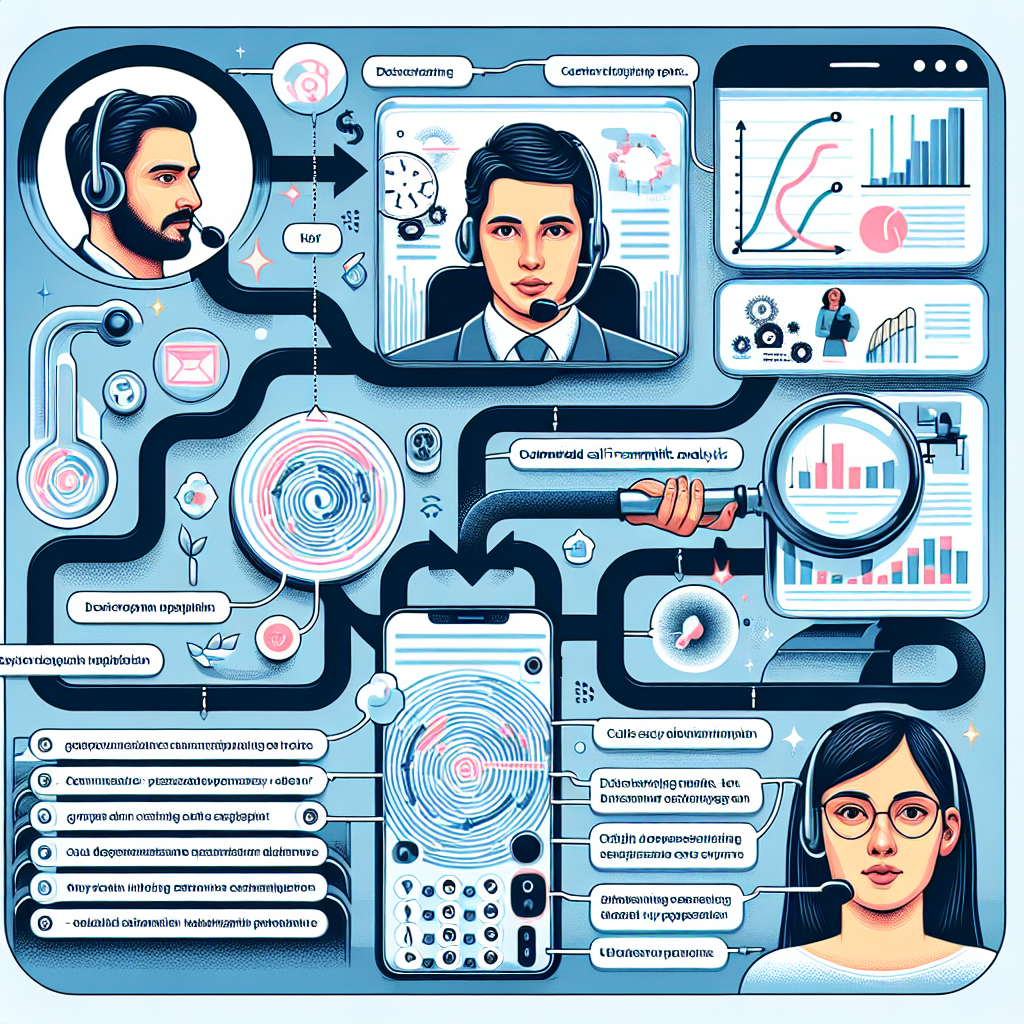
Understanding data is integral to enhance business performance. As part of this, interpreting customer interactions is crucial. This is where Automated Call Transcript Analysis comes into play, shaping the way businesses analyze their communication data.

Instead of manually sorting through calls, businesses can use Automated Call Transcript Analysis to extract key insights from every conversation. This handy tool can transform unstructured call data into valuable, actionable intelligence. But how does it actually work?
Adapting Artificial Intelligence (AI), this digital solution uses technology like Speech-to-Text and Natural Language Processing (NLP) to convert spoken words into a written format, and identify patterns within the text. This makes it possible to immediately analyze what is being discussed, the sentiment behind these discussions, and how these factors may impact the business.
Significance in Leveraging Business Communications:
Call transcript analysis can bring new strategic insights to your business. By analyzing and interpreting the phone calls between your firm and its clientele, it's possible to gain a better understanding of the customer journey and deepen your grasp of customer satisfaction levels. When used correctly, this can become a powerful tool for improving business strategy and providing actionable intelligence to your team.
So, whether it's gaining keep insights into customer needs, identifying up sell and cross sell opportunities, or reducing customer churn rate, Automated Call Transcript Analysis can help businesses tap into a gold mine of information that resides in the communication data.
Get a leg up on your competition by using this innovative tool to boost your business intelligence and gain a deep understanding of your clientele. Learn more about how this analysis can help your business.
Automated Call Transcript Analysis constitutes an innovative tool at the forefront of business intelligence. Its conceiving backbone is a potent blend of several advanced Artificial Intelligence technologies, the central ones being Natural Language Processing (NLP) and Machine Learning (ML).
Natural Language Processing is a subset of AI that equips machines with the capability to read, understand and decode human language in a worthwhile manner. In the context of automated call transcript analysis, NLP has two principal tasks. Firstly, it converts the spoken words during a call into written transcripts. Secondly, employing semantic analysis, it interprets these transcriptions, seeking out the inherent emotional tones, emphases, and even hidden significances. It also helps detect sentiment, which can add a layer of intelligence to the interpretation of the data. In practice, this signifies that NLP can understand and differentiate between a satisfied customer and a disgruntled one, by analyzing their respective interactions.
On the other hand, Machine Learning is another procurer of AI technologies that enables machines to learn autonomously from patterns and experiences. In relation to call transcript analysis, machine learning algorithms would be utilized to determine patterns, trends, and correlations within the gathered transcription data. Specifically, it enables the identification of common queries, repeated complaints, and the categorization of callers' intents. Such insights can be used by businesses to improve their customer service, adjust their product or services based on feedback, and preempt customer churn. Applications can found by looking into ML in customer service.
In summary, Automated Call Transcript Analysis merges the strengths of Natural Language Processing and Machine Learning to extract actionable business intelligence from raw, unstructured data plainly hidden in customer calls. The complexity embedded in this process is immense, considering it involves deciphering the nuances of human language and learning from it, thereby driving businesses to make more accurate, data-driven decisions derived from actual customer interactions.
With the prevalence of automated technologies, Automated Call Transcript Analysis has emerged as a valuable tool in the realm of business intelligence. Analyzing call transcripts manually can be time-intensive and prone to inaccuracies, while automated processes excel in these very areas. Here, we delve into some principal benefits of using Automated Call Transcript Analysis.

Foremost, improved customer service is a key advantage. Automated Call Transcript Analysis can identify common questions, concerns, and key phrases, thereby assisting businesses to better understand their clients' needs. This technology enables teams to rapidly capture customer sentiments and act upon them quicker than manual analysis could achieve.
Another significant benefit lies in product feedback loops. Simply from conversations, insights can be extracted related to product usability, flaws, and possibilities for enhancement. Enabling automated feedback loop mechanisms through call analysis can dynamically inform product development strategies, thereby minimizing business risks and maximizing customer satisfaction.
Lastly, efficient issue resolution sits at the heart of this technology. Automation can parse thousands of calls quickly, pin-pointing recurring issues and trends. By identifying common problems swiftly, businesses can adjust their practices and expedite resolution measures. Not only does this enhance the customer experience, but it also fosters operational efficiencies.
In conclusion, Automated Call Transcript Analysis serves as a smart tool, capable of driving meaningful enhancements in customer service, product development, and issue resolution. Businesses aiming to mine their call data for intelligence will find automated transcript analysis an asset in transforming data into actionable insights.
Few would dispute that automated call transcript analysis is a game changer. There’s no denying the fact that leveraging this ingenious automated process can lead to significant improvements in customer relations and internal operations. In the following case studies, we explore the real-world success stories of companies that have experienced the transformative power of call transcript analysis firsthand.
Coca-Cola, a globally renowned beverage company, used automated call transcript analysis to decipher customer sentiment and preferences. This allowed Coca-Cola to predict trends and preferences before they materialized in the market, providing it an upper hand over its competitors. The results? Improved product formulation and targeted promotional strategies that resonated with their consumers.
Another success story is the HSBC, one of the largest banking and financial services institutions globally. HSBC adopted the automated call transcript analysis to identify critical areas of customer dissatisfaction and process inefficiencies. The insights gleaned were used to streamline their processes, enhancing both customer satisfaction and operational efficiency. The changes brought by this action were demonstratively impactful, marking a significant boost in their customer retention rates.
Moreover, Vodafone, a leading telecommunications giant, successfully utilized call transcript analysis to track the productivity of their customer service team. By analysing calls, Vodafone was able to identify training gaps and performance variations amongst their customer representatives. The ongoing analysis provided an efficacious method of boosting productivity, subsequently leading to increased customer satisfaction.
What's clear from these cases is that no matter the company's size or the industry it operates within, automated call transcript analysis is an indispensable tool that can lead to transformative business intelligence. By harnessing the power of this technology, businesses stand a chance to greatly boost their operational efficiency, strengthen their customer relations, and keep a finger on the pulse of emerging trends, preferences, and sentiments.
As businesses deal with ever-growing volumes of communication data, there's an increasing demand for more effective ways to extract context from these data sources. One such method is Automated Call Transcript Analysis, which allows the extraction of valuable intelligence from phone call data. This technology assists businesses in transforming unstructured call data into structured data that can be analyzed intelligently. Key benefits of this process include improved customer service, more informed business decisions, and a competitive edge in predictive analytics.

However, to unlock its full potential, it's essential to seamlessly integrate automated call transcript analysis with existing business systems. These systems range from Customer Relationship Management (CRM) and Enterprise Resource Planning (ERP) systems to data analytics platforms. Integration methods vary, but the core goal is the same: enhancing the usability and applicability of the extracted data.
For instance, integrating call transcript analysis with a CRM system allows businesses to use customer call transcripts to assess customer satisfaction directly and build personalized communications. On the other hand, integration with ERP systems can uncover operational issues from customer complaints that might otherwise remain unseen. Moreover, by integrating automated call transcript analysis with data analytics platforms, companies can leverage Machine Learning and AI for superior predictive analysis.
In conclusion, to fully benefit from automated call transcript analysis, companies need to integrate this technology with their existing business systems. The integration should be seamless and purposeful, focusing on improving the business's understanding of its customers and operational practices. With the right integration, companies are well on their way to creating a more data-driven, customer-centric business model.
The outlook for automated call transcript analysis is promising, driven by continuous advancements in artificial intelligence (AI) and machine learning. These technologies are already transforming the way automated transcript analysis is conducted, revealing a wealth of business intelligence that drives decision making and operational efficacy.
One of the most exciting future trends is sentiment analysis, a complex AI technique used to detect, measure, and monitor customer emotions and attitudes. This technique interprets customers’ words, tone, and speech patterns to gain understanding of their sentiments towards a product, service, or brand. As AI becomes increasingly sophisticated, sentiment analysis will yield even more accurate and nuanced information, allowing companies to respond more effectively to their customer needs.
Next, the introduction of voice biometrics in the transcript analysis is expected to be a game-changer. Instead of just analyzing what is being said, voice biometrics can analyze who is saying it. This technology identifies unique voice characteristics to verify the speaker's identity, helping businesses combat fraud and enhance customer experiences.
Greater integration of AI into automated call transcript analysis is also anticipated in the near future. This approach will allow real-time feedback during calls, enabling customer service representatives to improve their performance and better address customer grievances on the spot. The future of transcript analysis holds much in store as AI unlocks new possibilities for businesses in the age of digital transformation.
Lastly, the growing popularity of real-time transcription is set to reshape automated call transcript analysis. Real-time transcription leverages AI to convert spoken words into written text instantly, offering myriad of applications from litigation proceedings to live broadcasting. This real-time transcription provides opportunities to drive increases in operational efficiencies, cost savings, and improved customer experiences as feedback can be given promptly.
Automated call transcript analysis tools built on these future trends promise to deliver profound business insights, thereby revolutionizing business practices and customer interactions.
Start your free trial for My AI Front Desk today, it takes minutes to setup!








